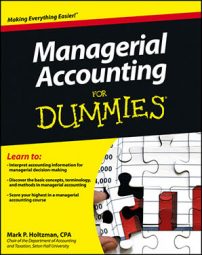After you know the cost of goods manufactured for a product, the next phase for the product is to store it as finished goods until your customers buy it — at which point you can figure out cost of goods sold. Cost of goods sold is a key figure on the income statement. It’s most companies’ largest expense and an important determinant of net income.
As with other phases of production (direct materials that go into production, work-in-process, and finished goods), you need to compute both the number of units sold and the cost of goods sold. The number of units sold helps you keep track of inventory as it flows through operations.
Cost information is critical to computing income and managerial decision-making. Furthermore, dividing cost of goods sold by the number of units sold yields the cost per unit, an important value when accounting for inventory.
The following formula computes the flow of inventory through any manufacturer or retailer:

Number of units sold
Companies need to know the actual number of units sold. To compute this amount, simply start with the number of units in beginning inventory of finished goods. Add the number of units manufactured, and subtract the number of units in ending inventory of finished goods.
In your chocolate milk factory, suppose that you started the year with 400 gallons of finished goods. Another 3,900 gallons were completed during the year. By the end of the year, you counted 100 gallons of finished goods:
Therefore, you must have sold 4,200 gallons of chocolate milk.
Cost of goods sold
To compute cost of goods sold, start with the cost of beginning inventory of finished goods, add the cost of goods manufactured, and then subtract the cost of ending inventory of finished goods.
Suppose your chocolate milk factory started out with $2,000 worth of beginning inventory of finished goods. Your cost of goods manufactured was $18,000, and your ending inventory of finished goods was $500:

You have $19,500 in cost of goods sold, an amount that goes right to the income statement. To figure out the cost per unit, divide the total cost by the 4,200 units sold: $3.64 ($19,500 ÷ 4,200 gallons).
As you may know from your financial accounting course, retailers use this same formula. Their inputs are purchases of merchandise. Furthermore, retailers have only one class of inventory rather than three (direct materials, work-in-process, and finished goods) because retailers usually purchase goods that are ready for sale.

